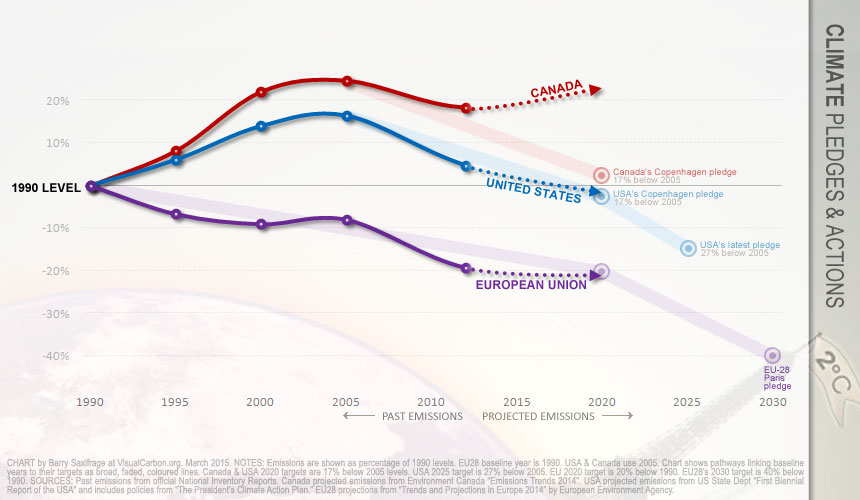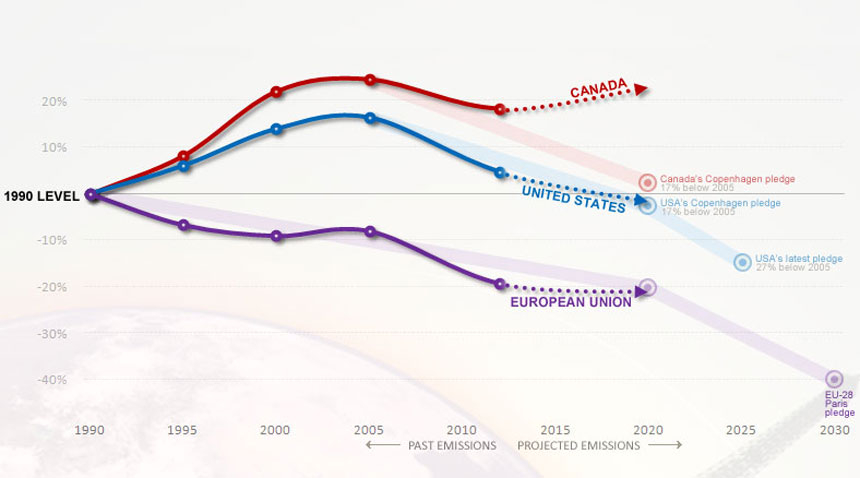As the world heads into the critical Paris 2015 climate conference, global pressure is increasing for nations to meet their current climate targets, and to pledge ambitious new targets for 2030.
A key strategy to avoid a repeat of Copenhagen 2009's failure is a requirement that all nations make their 2030 climate pledge known well before the Paris 2015 conference. This gives several months for the world to exert pressure on any foot-dragging nations to increase their ambition in the climate fight.
With pressure building and time running short, let's look at how Canada and it two largest trading partners — USA and European Union (EU28) — are doing so far.
Canada, America and EU28 all make the world's "top 10" lists for both economic production and climate pollution. These three tightly linked economies generate 40 per cent of the world's GDP. Combined they emit over a quarter of the world's climate pollution.
To compare how these three are doing on climate promises and ambition, I created the chart below using each nation's official climate publications.

CHART: Climate pollution changes and targets for EU28, USA and Canada relative to 1990. Solid lines are past emissions. Dotted lines are each nation's projected emissions. Bull's eyes are official climate pledges. Chart by Barry Saxifrage.
Both America and the EU28 are on track to meet their 2020 targets. Both have recently pledged new targets that require them to double their pace of emissions cuts.
Canada, in contrast, is rapidly falling behind and needs significant new climate policies to prevent dramatic failure.
Here are the details.
Europe meeting climate target, doubles ambition
The purple line in the chart shows emissions from the twenty eight nations of the EU28. The Europeans have promised to cut their climate pollution 20 per cent below their 1990 level by 2020. Already, their climate pollution is down 19 per cent and they expect to easily meet their 2020 climate target.
Going forward, the EU28 has unveiled their new 2030 commitment for Paris. Their new target is 40 per cent less climate pollution than in 1990. To meet this they will have to cut carbon emissions twice as quickly: 2 per cent per year.
Bottom line: On track and doubling their ambition.
USA close to climate target, doubles ambition
The Americans took longer to join the climate fight, but since then, they have led the world in total climate pollution cuts.
It wasn't until the Copenhagen 2009 climate conference that the US adopted a formal climate target. President Obama pledged that Americans would cut emissions 17 per cent below 2005 by 2020.
As my chart shows, this works out to 3 per cent below their 1990 level. While this is less than the Europeans compared to 1990, the Americans pledge has been more ambitious per year.
So far the Americans have cut emissions a bit faster than required. In addition they have a detailed plan that they project will get them close, and possibly beyond, their 2020 target.
Going forward, the US has unilaterally pledged to cut emissions another 10 per cent by 2025. That doubles the rate of pollution cuts per year and would leave them 15 per cent below 1990 by then. The Americans haven't unveiled their 2030 pledge yet.
Bottom line: On track and doubling their ambition.
Canada projects climate failure, silent on next round
In contrast to its two biggest trading partners, Canada is not cutting emissions fast enough and still lacks a plan to meet its 2020 target.
In 2009, both Prime Minister Stephen Harper and US President Barack Obama pledged to cut their nation's emissions to 17 per cent below their 2005 level by 2020. For Canada, this target works out to 3 per cent above their 1990 level.
As my chart shows, however, the climate pollution gap between the Americans and Canadians has been growing progressively wider since 1990. And projections for 2020 show Canada's climate gap becoming a chasm without aggressive new climate policies very soon.
Going forward, the Harper government has been quiet about Canada's new 2030 target. Something needs to be announced soon. It's going to be interesting.
Bottom line: Heading for failure and lacking ambition.
Other major nations make climate promises
A few other nations that have announced 2030 climate pledges:
- Switzerland was the first nation to formally declare their 2030 target for Paris. They pledged a 50 per cent emissions cut by 2030 with the caveat that up to 20 per cent of that might come from paying other nations to cut emission for them. Switzerland is not part of the EU28.
- Norway, a nation with a population and oil production similar to Alberta, pledged a 40 per cent emissions cut by 2030. Alberta in contrast is still dramatically increasing emissions: up 46 per cent since 1990. Norway is not part of the EU28.
- China promised to: create a national cap-and-trade by 2016 (the world's largest); to peak coal use by 2020; and to peak national emissions by 2030 or sooner. This unilateral and unconditional commitment to peak emissions is the first by any developing nation.
Next up: warnings from world's best climate science…
Rapidly increasing climate ambition by the world's three great economies — USA, EU28 and China — coincides with the arrival of the first clear climate impacts on human society.
As my next article will show, the latest and best climate science is clear that "widespread" and "unprecedented" changes are already upon us. The same science warns that these negative impacts will grow ever more dangerous until we stop fueling the crisis with our climate pollution.
Notes and sources for this article's chart:
- Past emissions data comes from each nation's official National Inventory Reports to the United Nations. I used the years 1990, 1995, 2000, 2005 and 2012 (latest available for all three).
- Canada's 2020 projected emissions from Environment Canada "Emissions Trends 2014".
- USA projected 2020 emissions from US State Dept "First Biennial Report of the USA" and includes policies from "The President’s Climate Action Plan." Dotted line is the mid-point of the range of listed outcomes.
- EU28's 2020 projections from “Trends and Projections in Europe 2014” by European Environment Agency.





Comments